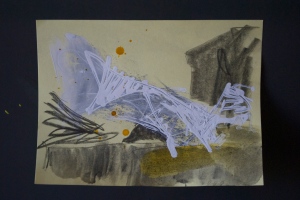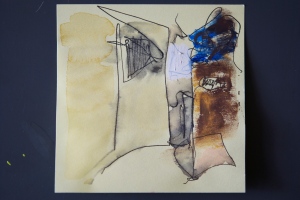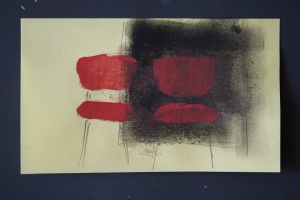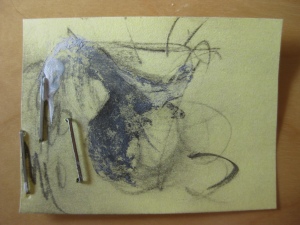What form of art or media do you work with?
At the moment mostly drawing and mixed media work but I’m going slowly back to painting.
Can you describe your studio/work space.
It’s a small bedroom in our flat, cluttered and organized to within an inch of its life, but it has wonderful light coming through a large window and opens out through a three quarter glass door onto the balcony. This gives the illusion of extra space. And I can brush pastel and charcoal dust out of the door.
Please give a brief description of your creation process and technique.
That’s difficult. I wait for a ‘moment’ and then home in on it. Does that make any sense? I’m not sure it does in words. I draw and paint things that grab my attention inside. The trick was learning to spot that moment when it happens and do something about it. With the blog I’m currently doing the pieces are all about messages, but a similar process is at work. I form messages about things or incidents that grab me, then I try to put the message into an image which both tries to reveal but which also tries to obscure the message.
What are you working on at the moment?
The thing which seems to have developed and taken up a life of it’s own in my art practice at the moment is a series of mixed media drawings on post-it notes which represent a series of messages. The whole project arose out of a situation I was in a while back where I ended up having to keep messages for myself in visual form to hide the real meaning and the whole nightmarish experience developed into what is now my blog Message Left
What can I say, it started off cathartic and ended up as something I can really work with.
It’s a series of drawings, each one essentially a visually codified message, and the idea is that the message, once it is taken out of the realm of words and put into an image, becomes obfuscated and hazy. Images are inherently less precise than words and I love that. I think what I’m trying to do is find out the extent to which I can push the message within the image and still keep the message inherent, at least in my eyes. I’d like the viewer to have to think about the image when they see it. The message shouldn’t be instantly clear. The viewer should have to work to see what’s going on.
It’s very different from everything I’ve ever done in the past because for the first time in my art I’m trying to obscure and cover up what I’m drawing, instead of reveal it.
While each post-it is a drawing I certainly wouldn’t try to claim each post-it is an art work, but since each is a message then if you put them together you get a sequence of messages, and so I see the whole sequence of post-its, essentially the whole blog, as the work itself.
As well at the blog I’m currently working some drawings up into full paintings but this involves a whole change of scale. It’s a work in progress.
How do you know when a work is complete?
I think that’s a very difficult question to answer. I’ve ruined many a piece over the years trying to find where the end point is. I’m no longer sure there is an endpoint with something as lateral as an image, there is only balance. When you have balance, whether that’s in composition, scale, palette or any combination of those, and the image is showing what you want to show then you can start to talk about it being complete. So I think in the end it’s only a feeling, followed by a decision.
Do you listen to music when you are working, or the radio, or work in silence?
I tend to work either in silence or I listen to jazz. Jazz is non-distracting. It’s very lateral-thinking sort of music.
What are you reading at the moment?
I’ve just finished Lionel Shriver’s We Need to Talk about Kevin, which was a bit harrowing, and I’m about to start Keri Hulme’s The Bone People, which I’m hoping is going to be less harrowing.
What is your favourite artwork by another artist?
The instinctive answer that pops into my head is Rachel Whiteread‘s ‘House’, even though it’s no longer with us. I love the accent and weight she imposes onto negative space and I feel instinctively that she’s right that it’s the space within a house that we live in, that we inhabit, less so the four walls themselves. ‘House’ really resonated with me.
Please complete the following sentences in whatever way is meaningful to you:
a) Artists should…… try to start from where they are, not from where they think they’re trying to get to
b) Art is.……. the way through the woods
c) The World is ……. infinitely interesting
What is the worst thing someone has said about your work?
“Oh that’s nice”, said while straining to look over their shoulder at something else.
Who is your favourite German Expressionist painter?
Max Beckmann. I am stunned by what I see as his ability to encode very complex thoughts and feelings into images. There is so much to see and absorb in his work. But if you mean favorite member of a formal German Expressionist group I’d go for Oskar Kokoschka. I love how he handles visual form through paint, and then handles a whole object through colour. He breaks everything down all the time, into what he sees as the constituent parts.
Thank you Louise




The work of Louise Harley-Smeur has the ability, through simple lines and spots, transport the viewer into a world of strong emotions.
This dynamic relationship that is created for me is perhaps the main strength of the work of Louise Harley-Smeur.
This interview confirms the value of their work.